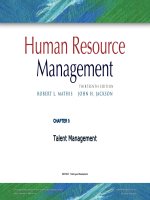Practical financial management lasher 7th ed chapter 09
Bạn đang xem bản rút gọn của tài liệu. Xem và tải ngay bản đầy đủ của tài liệu tại đây (643.66 KB, 59 trang )
Chapter 9 Risk and Return
Why Study Risk and Return?
Is there a way to invest in stocks to take advantage of the high returns while
minimizing the risks?
Investing in portfolios enables investors to manage and control risk while
receiving high returns.
– A portfolio is a collection of financial assets
2
The General Relationship Between
Risk and Return
Risk – The meaning in everyday language: The probability of losing
some or all of the money invested
Understanding the risk-return relationship involves:
– Define risk in a measurable way
– Relate that measurement to a return
3
Portfolio Theory—Modern Thinking about Risk and Return
Portfolio theory defines investment risk in a measurable way and relates it to the
expected level of return from an investment
– Major impact on practical investing activities
4
The Return on an Investment
The rate of return allows an investment's return to be compared with
other investments
One-Year Investments
– The return on a debt investment is
k = interest paid / loan amount
– The return on a stock investment is
k = [D1 + (P1 – P0)] / P0
5
The Expected Return
The expected return on stock is the return investors feel is most likely
to occur based on current information
– Anticipated return based on the dividends expected as well as the future
expected price
6
The Required Return
The required return on a stock is the minimum rate at which investors
will purchase or hold a stock based on their perceptions of its risk
7
Risk—A Preliminary Definition
A preliminary definition of investment risk is the probability that return
will be less than expected
Feelings About Risk
– Most people have negative feelings about
bearing risk: Risk
Aversion
– Most people see a trade-off between risk and return
– Higher risk investments must offer higher expected returns to be acceptable
8
Review of the Concept of a
Random Variable
In statistics, a random variable is the outcome of a chance process
and has a probability distribution
– Discrete variables can take only specific variables
– Continuous variables can take any value within a specified range
9
Review of the Concept of a
Random Variable
The Mean or Expected Value
– The most likely outcome for the random variable
For symmetrical probability distributions, the mean is the center of the
distribution.
Statistically it is the weighted average of all possible outcomes
n
X = ∑ XiP ( Xi )
i=1
10
Review of the Concept of a
Random Variable
Variance and Standard Deviation
– Variability relates to how far a typical observation of the variable is likely to
deviate from the mean
– The standard deviation gives an indication of how far from the mean a
typical observation is likely to fall
11
Review of the Concept of a
Random Variable
Variance and Standard Deviation
– Variance
(
)
2
Var X = σ = ∑ Xi − X P ( Xi )
i=1
2
x
n
Variance is the average squared deviation from the mean
Standard deviation
SD X
(
)
2
= σ x = ∑ Xi − X P ( Xi )
i=1
n
12
Concept Connection Example 9-1 Discrete Probability Distributions
X
P(X)
0
0.0625
1
0.2500
2
0.3750
3
0.2500
4
0.0625
The mean of this distribution is 2, since it is a
symmetrical distribution.
1.0000
If you toss a coin four times, what is the chance of getting x heads?
13
Figure 9-1 Discrete Probability Distribution
14
Concept Connection Example 9-2
Calculating the Mean of a Discrete Distribution
15
Concept Connection Example 9-3 Variance and Standard Deviation
16
Review of the Concept of a
Random Variable
The Coefficient of Variation
–
A relative measure of variation — the ratio of the standard deviation of a distribution to its
mean
CV = Standard Deviation ÷ Mean
σX
CV =
X
17
Review of the Concept of a
Random Variable
Continuous Random Variable
– Can take on any numerical value within some range
– The probability of an actual outcome involves falling within a range of values
rather than being an exact amount
18
Figure 9-2 Probability Distribution for a Continuous Random Variable
19
The Return on a Stock Investment as a Random Variable
Return is influenced by stock price and dividends
Return is a continuous random variable
The mean of the distribution of returns is the expected return
The variance and standard deviation show how likely an actual return
will be some distance from the expected value
20
Figure 9-3 Probability Distribution of the Return on an Investment in
Stock X
21
Figure 9-4 Probability Distributions With Large and Small Variances
22
Risk Redefined as Variability
In portfolio theory, risk is variability as measured by variance or standard deviation
A risky stock has a high probability of earning a return that differs significantly from the mean
of the distribution
A low-risk stock is more likely to earn a return similar to the expected return
In practical terms risk is the probability that return will be less than expected
23
Figure 9-5 Investment Risk Viewed as Variability of Return Over Time
Both stocks have the same expected return,
the high risk stock has a greater variability
in return over time.
24
Risk Aversion
Risk aversion means investors prefer lower risk when expected returns
are equal
When expected returns are not equal the choice of investment
depends on the investor's tolerance for risk
25









